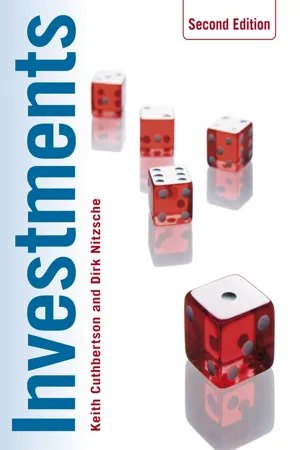Business
Net Present Value
Net Present Value (NPV) is a financial metric used to evaluate the profitability of an investment or project. It calculates the present value of all future cash flows generated by the investment, taking into account the time value of money. A positive NPV indicates that the investment is expected to generate more value than the initial cost, making it an attractive opportunity.
Written by Perlego with AI-assistance
Related key terms
1 of 5
11 Key excerpts on "Net Present Value"
- Daniel Adrian Doss, William H. Sumrall III, Don W. Jones(Authors)
- 2017(Publication Date)
- Routledge(Publisher)
Some initiatives may require periods that are longer than those that are considered within this text. When these situations occur, it is recommended that NPV calculations be performed through the use of software spreadsheets, proprietary software, or financial calculators. Also, within the context of collegiate finance courses, a tabular solution is also available to solve NPV problems involving a variety of periods. However, for the purposes of this text, the use of the basic formula is appropriate to demonstrate the basic concept of Net Present Value and to delineate the calculations through which NPV problems are solved. Future editions of this text, if any, are anticipated to contain the tabular solution methods of NPV problems.6.8 Chapter Comments and Summary
This chapter introduced the Net Present Value (NPV) method of capital budgeting. The methods of capital budgeting encompass perspectives of time, cash value, rate, and profitability potential. The NPV is indicative of a cash perspective regarding the rendering of capital budgeting decisions. Further, the NPV method incorporates the time value of money within its primary construct. Derivation of the NPV method can occur through algebraic manipulation of the current monetary value formula given in Chapter 4 .The NPV method involves a consideration of the anticipated cash flows of a capital investment through time. These anticipated future values are discounted to determine their current monetary equivalencies. Conceptually, the NPV is the sum of the present monetary value of the anticipated future cash flows of a potential capital investment excluding the costs of investment. Therefore, the NPV method provides a cash-based perspective regarding capital budgeting initiatives. The NPV may be used as a solitary method of capital budgeting or may be used in conjunction with any (or all) of the capital budgeting methods described within this text. The NPV method may be used to examine single capital initiatives or multiple capital initiatives. Further, this method may be used with or without the constraints imposed by mutual exclusion conditions.- eBook - PDF
- Robert Parrino, David S. Kidwell, Thomas Bates(Authors)
- 2016(Publication Date)
- Wiley(Publisher)
In fact, that is what business is really all about – dealing with uncertainty and making decisions that involve risk. In conclusion, the NPV approach is the method we recommend for making capital invest-ment decisions. The accompanying table summarises NPV decision rules and the method’s key advantages and disadvantages. Summary of Net Present Value (NPV) Method Decision Rule: NPV > 0 ➪ Accept the project. NPV < 0 ➪ Reject the project. Key Advantages Key Disadvantages 1. Uses the discounted cash flow valuation technique to adjust for the time value of money. Can be difficult to understand without an accounting and finance background. 2. Provides a direct (monetary) measure of how much a capital project will increase the value of the firm. 3. Consistent with the goal of maximising shareholder value. Before You Go On 1. What is the NPV of a project? 2. If a firm accepts a project with a €10 000 NPV, what is the effect on the value of the firm? 3. What are the five steps used in NPV analysis? 10.3 The Payback Period The payback period is one of the most widely used tools for evaluating capital projects. The payback period is defined as the number of years it takes for the cash flows from a project to recover the project’s initial investment. With the payback method for evaluating projects, a pro-ject is accepted if its payback period is below some specified threshold. Although it has serious LEARNING OBJECTIVE 3 payback period The length of time required to recover a project’s initial cost. 10.3 The Payback Period 337 weaknesses, this method does provide some insight into a project’s risk; the more quickly you recover the cash, the less risky is the project. Computing the Payback Period To compute the payback period, we need to know the project’s cost and estimate its future net cash flows. The net cash flows and the project cost are the same values that we used to compute the NPV calculations. - eBook - ePub
Making the Compelling Business Case
Decision-Making Techniques for Successful Business Growth
- W. Messner(Author)
- 2013(Publication Date)
- Palgrave Macmillan(Publisher)
It is now time to revisit the result of the calculation: the NPV is negative and thus the calculation uncovers a non-profitable investment proposition. But what would happen if the rate of return drops from 5 per cent to 3.5 per cent? Changing the value in cell E18 to 3.5 per cent throws out a positive NPV in cell E16 and the investment proposition begins to make sense again. Alternatively, if the owner of the real estate manages to rent it out at higher rates, this could for example increase the cash inflow in the first two years to $20,000 and to $25,000 in the third and fourth year. Now the calculation shows a positive NPV of $1,115.Spreadsheets like the one in Figure 2.6 help to experiment with the input data and thus facilitate a deeper understanding of an investment’s otherwise hidden dynamics. This kind of experimenting is commonly referred to as sensitivity analysis and Section 6.6 examines its possibilities in greater detail.Summary
The firm’s wealth maximization goal (see Section 1.1 ) states that financial management should endeavor to maximize the NPV of the expected future cash flows by taking two basic parameters into account2 :The longer it takes to receive a cash flow, the lower the value decision makers place on the cash flow today.The greater the risk associated with receiving a future cash flow, the lower the value decision makers place on that cash flow today.The wealth maximization goal thus reflects the magnitude, timing, and risk associated with cash flows expected to be received in the future as a result of investment decisions. It tells financial management what investments are to be preferred and how to make decisions.However, people often fail to understand the simple mathematical rationale of the time value of money, which is really the only principle behind calculating NPV. Instead, they perceive some other methods as methodically easier to understand, apply them instead, and in this process often mess up the correctness of the calculation. NPV is always (!) the most appropriate approach to calculating business cases; Sections 2.3 –2.6 describe the most common alternative methods, highlight their weaknesses (and strengths, if at all), and explain why they are always (!) inferior to the NPV method when making decisions on investment propositions. Sometimes they are indeed appropriate to use, but the same decision can always (!) be reached with the much more straightforward NPV method. Chapter 5 - eBook - PDF
Managerial Accounting
The Cornerstone of Business Decision Making
- Maryanne Mowen, Don Hansen, Dan Heitger, , Maryanne Mowen, Don Hansen, Dan Heitger(Authors)
- 2017(Publication Date)
- Cengage Learning EMEA(Publisher)
Now compute the present value of the profit earned on the investment. 2. CONCEPTUAL CONNECTION Compute the NPV of the investment. Compare this with the present value of the profit computed in Requirement 1. What does this tell you about the meaning of NPV? Exercise 12-39 Solving for Unknowns Each of the following scenarios is independent. Assume that all cash flows are after-tax cash flows. a. Thomas Company is investing $120,000 in a project that will yield a uniform series of cash inflows over the next 4 years. b. Video Repair has decided to invest in some new electronic equipment. The equipment will have a 3-year life and will produce a uniform series of cash savings. The NPV of the equipment is $1,750, using a discount rate of 8%. The IRR is 12%. OBJECTIVE 3 ▶ OBJECTIVE 1 ▶ 3 ▶ 4 ▶ Copyright 2018 Cengage Learning. All Rights Reserved. May not be copied, scanned, or duplicated, in whole or in part. WCN 02-300 687 Chapter 12 Capital Investment Decisions c. A new lathe costing $60,096 will produce savings of $12,000 per year. d. The NPV of a project is $3,927. The project has a life of 4 years and produces the following cash flows: Year 1 $10,000 Year 3 $15,000 Year 2 $12,000 Year 4 ? The cost of the project is two times the cash flow produced in Year 4. The discount rate is 10%. Required: 1. If the internal rate of return is 14% for Thomas Company, how much cash inflow per year can be expected? 2. Determine the investment and the amount of cash savings realized each year for Video Repair. 3. For Scenario c, how many years must the lathe last if an IRR of 18% is realized? 4. For Scenario d, find the cost of the project and the cash flow for Year 4. Exercise 12-40 Net Present Value versus Internal Rate of Return Skiba Company is thinking about two different modifications to its current manufacturing pro-cess. - eBook - PDF
Managerial Accounting
Tools for Business Decision-Making
- Jerry J. Weygandt, Paul D. Kimmel, Donald E. Kieso, Ibrahim M. Aly(Authors)
- 2018(Publication Date)
- Wiley(Publisher)
ILLUSTRATION 13.18 Net Present Value calculation Project A Project B Present value of net cash flows $58,112 $110,574 Initial investment 40,000 90,000 Net Present Value $18,112 $ 20,574 Capital Budgeting Challenges 603 Project B has the higher NPV, and so it would seem that the company should adopt B. Note, however, that Project B also requires more than twice the original investment of Project A. In choosing between the two projects, the company should also include in its calculations the amount of the original investment. One relatively simple method of comparing alternative projects is the profitability index. This method considers both the size of the original investment and the discounted cash flows. The profitability index is calculated by dividing the present value of cash flows that occur after the initial investment by the initial investment. Illustration 13.19 shows the formula. Present Value of Net Cash Flows Initial Investment Profitability Index ILLUSTRATION 13.19 Formula for profitability index The profitability index makes it possible to compare the relative desirability of projects that require different initial investments (see Decision Tools). Note that any project with a pos- itive NPV will have a profitability index above 1. The profitability index for the two projects is calculated in Illustration 13.20. Profitability Index = Present Value of Net Cash Flows Initial Investment Project A Project B $58,112 = 1.45 $110,574 = 1.23 $40,000 $90,000 ILLUSTRATION 13.20 Calculation of profitability index In this case, the profitability index of Project A exceeds that of Project B. Thus, Project A is more desirable. Again, if these were not mutually exclusive projects, and if resources were not limited, then the company should invest in both projects, since both have positive NPVs. Additional matters to consider in preference decisions are discussed in more advanced courses. - James J. Farley(Author)
- 2009(Publication Date)
- CRC Press(Publisher)
In some cases, later cash flows inward can be very large, and a proj-ect not undertaken because it did not show rapid payback, may, in the long run, be the better one. If the initial cash flow outward is not a single large instantaneous payment, but rather a series of cash flows over time, simply treat them as negative items as they occur. If you are evaluating two or more projects on the basis of the payback period method, you would consider the one showing the earliest repayment as the “best,” and so forth for the second and third place projects. Keep in mind that this calculation only considers the time required to pay back the initial investment; it does not consider overall total profit of the project. In the Net Present Value ( NPV ) method, the Net Present Value of cash flows are computed for each year of a project’s anticipated or effective existence. A value is obtained for each project under consid-eration. The one with the greatest Net Present Value is chosen first. The one with the next largest Net Present Value is selected second and so on (see Table 4.12). As an example of a Net Present Value computation, let’s use the same project analyzed in the payback period example. Table 4.11 shows cash flows in the second column and the cumulative cash flow in the FINANCE 79 right column with figures in parentheses indicating negative values. Assume the anticipated life of the project is five years. In year 0 (today), a $5,000 expenditure or cash flow outward occurred. Subsequently, $2,000 was received as a positive cash flow in year 1, $2,000 in year 2, $3,000 in year 3, $3,000 in year 4, and $4,000 in year 5. Although the example indicates cash received, we are calculating at a point before the project begins. Thus we are cal-culating anticipated cash flows (not true received cash) to determine whether we will or will not implement the project. Be aware that all these calculations are made before the fact and all the numbers repre-sent anticipated cash.- eBook - PDF
- Keith Cuthbertson, Dirk Nitzsche(Authors)
- 2014(Publication Date)
- Wiley(Publisher)
We can now think of ranking these projects according to their NPVs, from highest to lowest. Hence: NPV = CF 1 - KC 1 (1 + r) + CF 2 - KC 2 (1 + r) 2 - KC 0 KC i VALUATION TECHNIQUES 90 When funds are available, invest in all projects for which the NPV is positive. However, note that if there is a capital constraint on finance, then the NPV criterion is mis- leading (see ‘performance index’ below). Valuation of the whole firm The PV approach can be used to value the whole firm. Here we merely aggregate the free cash flows and capital costs from all the firm’s current and planned projects and find their total NPV. It can be shown that: If managers invest in all positive NPV projects, then this maximises the value of the firm and maximises the returns to shareholders. But if today we offered to give another Bank B $2,420 in two years time, how much would Bank B give us today (as a loan)? It would give us today: So once again we find that our profits are worth $2000 today – but this is less than the capital cost of project of KC $2100, so we would not go ahead with the deli. As long as you adjust any cash flows to the same point in time and only then compare them, you will always came to the same decision about the viability of an investment. DPV = $2420> (1.1) 2 = $2000 The PV approach is one way in which stock analysts try to calculate the ‘fair value’ of the firm to see if it is currently over- or undervalued. Suppose that by summing the NPVs of all the divisions of the firm the analyst finds that the NPV of the firm is V firm $100m. If this is an all-equity firm and there are N 10m shares outstanding, then the ‘fair value’ of these shares is V s $10 per share ( 100/10). If the shares are currently trading at P $9, then the analyst might recommend purchasing this undervalued share. - eBook - PDF
- James Jiambalvo(Author)
- 2016(Publication Date)
- Wiley(Publisher)
Capital expenditure decisions are investment decisions involv- ing the acquisition of long-lived assets. A capital budget is the final list of approved acquisitions. Two of the primary methods for evaluating investment opportunities, which take into account the time value of money, are the Net Present Value method (NPV) and the internal rate of return method (IRR). The Net Present Value method equates all cash flows to their present values. If the sum of the present values of cash inflows and outflows (i.e., the NPV) is zero or positive, the return on the investment equals or exceeds the required return and the investment should be made. The internal rate of return method calculates the rate of return that equates the present value of the future cash flows to the initial investment. If this rate of return is equal to or greater than the required rate of return, the investment is warranted. LEARNING OBJECTIVE 2 Calculate the depreciation tax shield and evaluate long-run decisions, other than investment decisions, using time value of money techniques. In analyzing cash flows for a Net Present Value analysis or an internal rate of return analysis, remember that depreciation is not a cash flow but the tax savings generated by depreciation are relevant to the analysis. The tax savings owing to depreciation are referred to as the depreciation tax shield. NPV and IRR are also used to evaluate long-run decisions that are not capital budgeting decisions. Examples include outsourcing decisions and decisions related to multiyear adver- tising campaigns. LEARNING OBJECTIVE 3 Use the payback period and the accounting rate of return methods to evaluate investment opportunities, and explain why managers may concentrate erroneously on the short-run profitability of investments rather than their Net Present Values. The payback method evaluates capital projects in terms of how quickly the initial investment is recovered by future cash inflows. - eBook - PDF
- Raghavendra Rau(Author)
- 2016(Publication Date)
- Cambridge University Press(Publisher)
Managers need to just focus on maximizing NPV, given by equation 2.1 . This equation needs three inputs, two obvious and explicit and one not so obvious. The two obvious inputs are the cash flows, CF and the interest rate, r. The not-obvious (implicit) input is the financing decision of the firm – how the firm chooses to raise funds to invest in the investment opportunity. As we will see in the chapter on capital structure, we usually take the capital structure into account in the discount rate (the interest rate). The discount rate itself is determined by investors; we will The NPV Formula 33 see how this is derived in the next chapter , using portfolio theory and the capital asset pricing model. What about the cash flows? It turns out that we have only four types of cash flows in corporate finance: single lump sums, annuities, perpetuities, and continuously compounded cash flows. Of these, the first three are most commonly used in corporate finance applications, while the last is typically used in option pricing. An example of a single lump sum is a single cash flow received a few years off. For example, if you expect an inheritance of £10,000 three years from now, that is a single lump sum. The present value will be PV FV r r nobreakspace nobreakspace 1 nobreakspace nobreakspace 10,000 1 T 3 ( ) ( ) = + = + where FV is the future value, r is the discount rate, and T is the number of periods till we receive the future value. The future value is obtained by inverting the present value formula. In the example above, 10,000 = PV(1 + r) 3. In general, the PV is given by PV FV r 1 t ( ) = + (2.2) and the FV is given by: FV PV r 1 t ( ) = × + (2.3) An annuity is a series of cash flows that (1) are constant, (2) end after a while, and (3) earn the same interest rate throughout. - eBook - PDF
Corporate Finance
Theory and Practice in Emerging Economies
- Sunil Mahajan(Author)
- 2020(Publication Date)
- Cambridge University Press(Publisher)
Managers are paid to take decisions. They cannot sit back and relax or spend time playing golf in the afternoon after having once decided to invest in a project. A constantly changing environment leads to the re-evaluation of earlier decisions, as and when warranted. Changes in cash flows and the consequent risk of the project implies that managers need to estimate and manage such risks. There are various methods to do so. A discussion of these methods is beyond the scope of this book. KEY CONCEPTS 1. Capital-budgeting decisions have a significant impact on a company’s fortunes over long term. 2. A project’s worth is based on the cash-flow generation and not accounting figures. 3. A company must select projects that have the potential to generate positive NPV. Net Present Value is superior to alternative capital-budgeting methods. 4. If two projects are mutually exclusive, the one with the higher NPV is selected. 5. The increase in the value of the firm from its capital budget for the year is the sum of the NPVs of all accepted projects. 6. Internal rate of retrun, payback period and ARR are the other methods employed to evaluate projects. 7. Cash flows for a project are incremental in nature, include opportunity costs, exclude sunk costs, recognize cannibalization and take into account taxes and inflation. What needs to be estimated are ‘post-tax incremental cash flows’. 8. Cash flows must include depreciation and other non-cash expenses. 116 | Corporate Finance 9. Cash flows for a project comprise initial, operating and terminal cash flows. 10. The impact of inflation must be taken into account in determining future cash flows. 11. Future cash flows are mere estimates and could turn out to be very different. The risk embedded in cash flow estimation must be taken into consideration. CHAPTER QUESTIONS 1. Capital budgeting is not a daily activity. Why is it still so critical to a company’s long-term future? 2. - eBook - PDF
- Don Hansen, Maryanne Mowen, Dan Heitger, , Don Hansen, Maryanne Mowen, Dan Heitger(Authors)
- 2021(Publication Date)
- Cengage Learning EMEA(Publisher)
For example, an investment of $100,000 that produces a cash f low one year from now of $121,000 has the same IRR (21 percent) as an investment of $10,000 that produces a cash f low one year from now of $12,100. Note, however, that the NPV is $10,000 for the first invest-ment and $1,000 for the second. Since absolute measures often produce different rankings than relative measures, it shouldn’t be too surprising that NPV and IRR can, on occasion, produce different signals regarding the attractiveness of projects. When a conf lict does occur between the two methods, NPV produces the correct signal, as can be shown by a simple example. Assume that a manager is faced with the prospect of choosing between two mutually exclu-sive investments whose cash flows, timing, NPV, and IRR are given in Exhibit 19.1. (A required rate of return of 8 percent is assumed for NPV computation.) Both projects have the same life, require the same initial outlay, have positive NPVs, and have IRRs greater than the required rate of return. However, Project A has a higher NPV, whereas Project B has a higher IRR. The NPV and IRR give conf licting signals regarding which project should be chosen. The preferred project can be identified by modifying the cash f lows of one project so that the cash f lows of both can be compared year by year. The modification, which appears in Exhibit 19.2, was achieved by carrying the Year 1 cash f low of Project B forward to Year 2. This can be done by assuming that the Year 1 cash f low of $686,342 is invested to earn the required rate of return. Under this assumption, the future value of $686,342 is equal to $741,249 (1.08 3 $686,342). When $741,249 is added to the $686,342 received at the end of Year 2, the cash f low expected for Project B is $1,427,591. As can be seen from Exhibit 19.2, Project A is preferable to Project B. It has the same out-lay initially and a greater cash inf low in Year 2.
Index pages curate the most relevant extracts from our library of academic textbooks. They’ve been created using an in-house natural language model (NLM), each adding context and meaning to key research topics.










